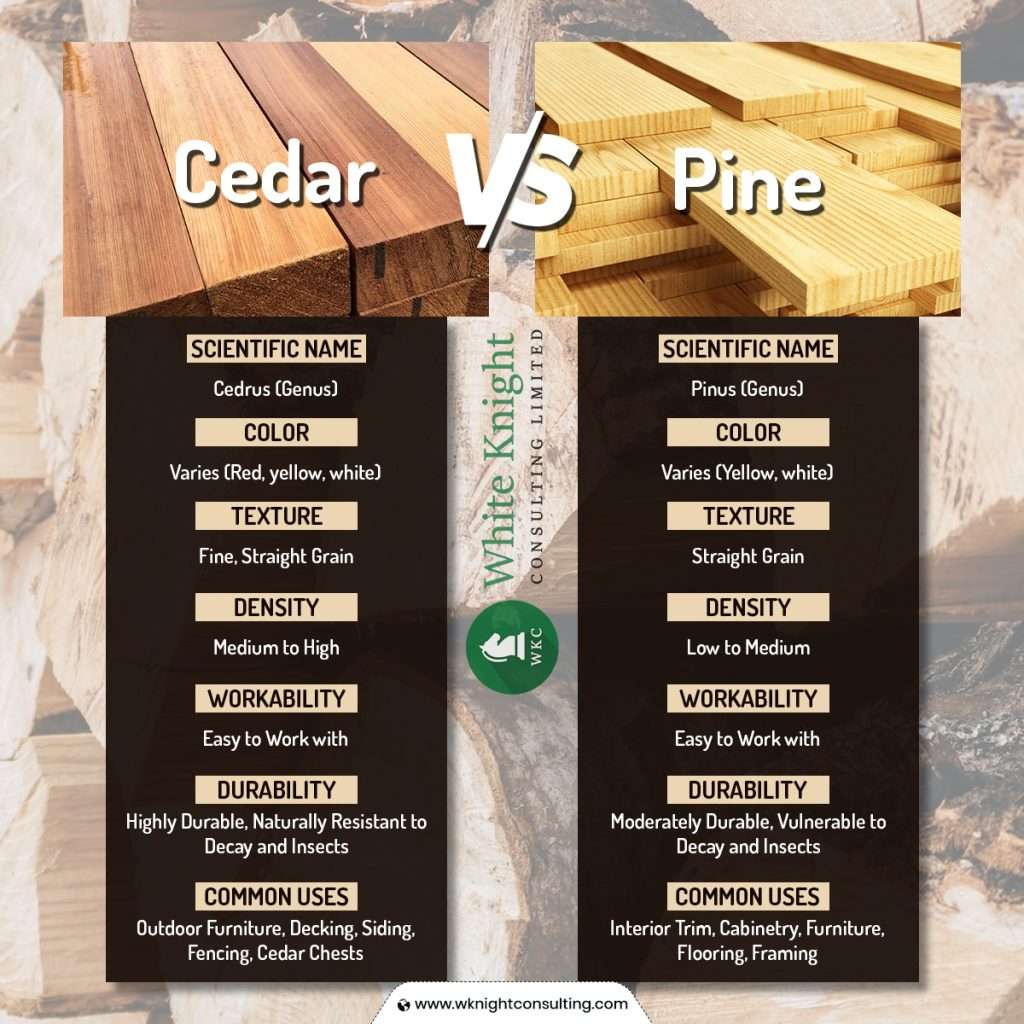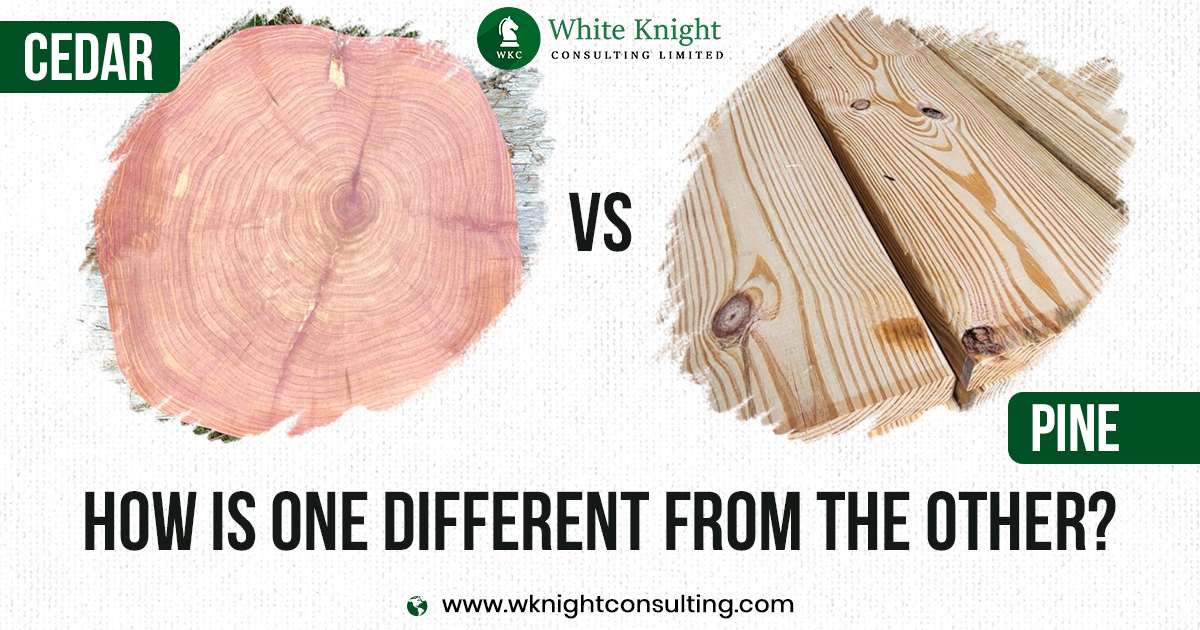If you’re looking to compare cedar vs pine wood species or are curious about how pinewood is different from cedar, which is also a softwood, this article is for you.
Softwood is a type of wood that is extracted from coniferous trees that remain evergreen or never shed their leaves. Conifer trees have cones and needles for leaves. Softwoods are generally softer and less durable than hardwoods, but there are exceptions.
Pine and cedar are two popular types of softwood. Both are moderately strong and durable and are used across a wide range of applications, mostly interior. Here’s everything you need to know about the difference between pine and cedar softwood species.
What is Cedar?
Cedar has many species, most of which are used for making high-quality furniture. Cedar is known for its beautiful appearance, high durability, and natural aroma. It is resistant to rot and insects and is also suitable for outdoor use.
Some popular species of cedar include eastern red cedar, western red cedar, yellow cedar, northern white cedar, and Spanish cedar.
What is Pine Wood?
Pine is one of the most popular softwood species. It is generally softer than cedar and moderately durable in terms of resistance to decay and pests. Pine is a popular choice for woodworkers because of its abundant availability and cheap price.
Major species of pine include lodgepole pine, sugar pine, jack pine, limber pine, Jeffrey pine, red pine, eastern white pine, longleaf pine, yellow pine, and western white pine.
Cedar vs Pine : Which Wood Species Takes the Lead?

Both pine and cedar are readily and easily available woods and are generally less expensive than many popular hardwoods. Choosing between the two is not an easy task because they share many common properties. Both are easy to work with. While pine timber is less expensive, cedar is more durable than pine. Let’s start talking about the differences between pine and cedar.
Appearance
Colour
Cedar has a darker reddish-brown shade with warm undertones, while pine commonly has a lighter colour ranging from pale yellowish-white to light yellow or light brown. Cedar is richer and can develop a greyish layer on its surface over time, while pine maintains a more even and consistent colour over its age.
Grain & Texture
Cedar typically has a straight grain with a fine texture. It is easy to identify by knots and distinctive patterns on its surface. Pine, on the other hand, has a straight or wavy grain and a medium texture. It can also have knots, but less than cedar, and occasional resin pockets, which give it a more rustic look.
Physical Properties
Trees
Cedar and pine are both conifer trees that belong to different genera and have different characteristics. Cedar trees are typically tall evergreen trees known for their aromatic wood, while pine trees are also evergreen but have needle-like leaves and produce cones. Cedar trees often have a more conical shape, while pine trees can have a variety of shapes, including pyramidal or irregular. Each tree species has its own unique traits and features.
Pine trees are found all over the world, but are more common in the Northern Hemisphere. Cedar can be found in many parts of Europe, Asia, and North America.
Wood Strength
In terms of strength, cedar and pine have some differences. Cedar wood is known for its natural durability and resistance to rot, insects, and decay, making it a strong choice for outdoor applications. Pine wood is generally softer and less dense than cedar, making it more prone to dents and damage.
Hardness
Both Cedar and Pine wood, depending on the species, can vary in hardness, While pine generally falls within the range of 380 to 870 lbf, the Janka rating of cedar ranges from 320 to 900 lbf. Some species of pine are harder than others. Southern yellow pine (Janka rating 870 lbf), for instance, is even harder than many hardwoods.
Density/Weight
Cedar wood can be more or less dense than pine depending on the species. The specific density and weight of cedar can vary in the range of 24 to 34 pounds per cubic foot (pcf) depending on the species. Pine, on the other hand, has a density ranging from 25 to 40 pcf, depending on the type.
Durability
Cedar wood is known for its high natural durability due to the presence of natural oils and compounds that make it resistant to things like moisture, rot, decay, and insects. It can be used in outdoor applications without treatment. Pine wood is only moderately durable and needs to be properly treated and maintained when being used for outdoor applications.
Workability
Both cedar and pine are considered easy to work with. Cedar has a straight grain and fine texture, which makes it easy to work with both hand or machine tools. It also accepts finishes well. Pine also has good workability, but the resins in the wood can sometimes cause problems. It may also be slightly more prone to splintering due to its softer character.
Availability & Price
Availability
The availability of cedar and pine can vary depending on your location and availability of suppliers.
Cedar is often more easily available in areas where cedar trees are native, such as North America and some parts of Europe. Pine, on the other hand, is more widely available in many parts of the world due to its widespread distribution and plantation.
Price
The price of cedar and pine depends on many factors such as the specific species, location, grade of wood, and availability.
Generally, cedar is more expensive than pine due to limited availability and superior properties like a darker appearance and natural durability. Pine, on the other hand, is more widely available and is, therefore, more affordable and accessible than cedar.
Uses
Cedar and pine have various uses due to their amazing characteristics.
- Cedar wood’s natural durability and resistance to moisture and insects make it a popular choice for outdoor applications like outdoor furniture, decking, siding, flooring, and fences. It is also used in various other construction and interior applications, including furniture, cabinets, and aromatic cedar chests.
- Pine is particularly prized for its affordability, easy availability, and workability. It is a popular choice for interior woodworking, such as furniture making, beds, tables, cabinetry, trim, and panelling. It is also commonly used for the construction of frames, flooring, and plywood. Additionally, as a soft wood that is easy to carve, pine is also considered a good choice for crafting and DIY projects.
Both kinds of wood offer a wide range of applications depending on their unique qualities and aesthetic appeal.
Buy Construction-Grade Pine & Cedar Online
Cedar and pine are two very popular species of softwood with their own distinct properties, advantages, and disadvantages. You can read the detailed differences above to choose between cedar and pine wood based on the specific type and requirements of your project.
At the White Knight Consulting LTD, you can read more details about cedar wood and pine timber and compare them based on various properties and uses to buy the best timber for your project. We specialise in manufacturing and supplying the best, sustainable wood products, including popular hardwoods, softwoods, and timber with 40+ species to choose from. Give us a call today to discuss your timber requirements.
